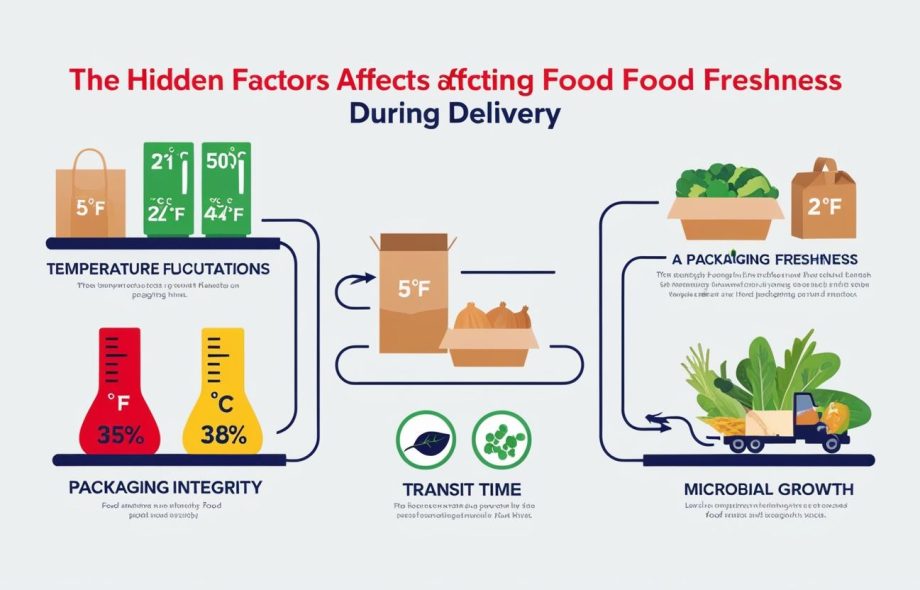Food delivery has become an essential part of modern life, offering convenience and a wide variety of culinary options. However, maintaining food freshness from the restaurant to the customer’s doorstep is a complex challenge. Factors like ventilation, temperature control, and contamination risks can significantly impact food quality.
One of the most critical elements in preserving freshness is packaging—specifically, custom food boxes, insulated packaging, and food delivery containers. These solutions help mitigate spoilage, but many hidden factors still influence food integrity during transit.
In this article, we’ll explore the unseen elements that affect food freshness and how the right packaging can make all the difference.
1. Temperature Control: The Biggest Challenge in Food Delivery
Temperature fluctuations are one of the primary reasons food spoils during delivery. Hot food must stay hot, and cold food must stay cold—otherwise, bacterial growth accelerates, leading to spoilage and potential health risks.
How Packaging Helps Maintain Temperature
Insulated Packaging: Materials like foam or thermal liners help retain heat or cold, keeping food at safe temperatures longer.
Double-Walled Containers: These provide an extra layer of insulation, reducing heat transfer.
Gel Packs & Phase Change Materials: Often used for perishable items, these maintain consistent temperatures during transit.
Pro Tip: Restaurants should use custom food boxes designed for specific meal types—thermal bags for pizza, vacuum-sealed containers for soups, and insulated boxes for ice cream.
2. Ventilation: Why Airflow Matters in Food Packaging
While insulation is crucial for temperature-sensitive foods, some dishes require proper airflow to prevent sogginess. Items like fried chicken, crispy fries, or fresh salads can lose texture if trapped in a completely sealed container.
Best Ventilation Practices
Perforated Containers: Small holes allow steam to escape, keeping fried foods crispy.
Breathable Lids: Some food delivery containers come with vented lids to regulate moisture.
Separate Compartments: Dividing wet and dry ingredients (like noodles and broth) prevents unwanted sogginess.
Common Mistake: Over-sealing food can lead to condensation, making breads and pastries mushy.
3. Contamination Risks: How Packaging Prevents Cross-Contamination
Food safety is non-negotiable. Contamination can occur from:
Bacteria transfer (e.g., raw meat juices leaking onto salads)
Chemical leaching (low-quality plastic containers)
Physical contaminants (dust, insects, or unclean delivery bags)
How to Mitigate Contamination
✔ Leak-Proof Containers: Sauces and liquids should stay contained.
✔ Tamper-Evident Seals: Ensures food hasn’t been exposed during transit.
✔ Food-Grade Materials: BPA-free, FDA-approved packaging prevents chemical leaching.
Best Practice: Use custom food boxes with secure locking mechanisms to prevent spills and exposure.
4. Time in Transit: The Longer the Delivery, the Higher the Risk
Even with perfect packaging, extended delivery times increase the risk of:
Temperature drops (hot food gets cold, cold food warms up)
Texture degradation (crispy foods soften, salads wilt)
Bacterial growth (perishable items like dairy or seafood spoil faster)
Solutions to Reduce Transit Time Impact
Optimized Delivery Routes: GPS tracking helps drivers take the fastest path.
Pre-Cooled/Pre-Heated Packaging: Some insulated packaging is pre-treated to maintain temps longer.
Real-Time Monitoring: Smart containers with temperature sensors alert drivers if food is at risk.
Did You Know? Some third-party delivery services now use AI to predict optimal delivery times based on traffic and weather.
5. The Role of Custom Food Boxes in Branding & Customer Experience
Beyond freshness, packaging also impacts brand perception. A well-designed custom food box can:
✅ Enhance Unboxing Experience (e.g., branded pizza boxes with clever designs)
✅ Improve Functionality (stackable, microwave-safe, or compostable options)
✅ Reduce Waste (eco-friendly materials appeal to sustainability-conscious customers)
Example:
Conclusion: Need Custom Packaging = Fresher Food & Happier Customers
Food freshness during delivery depends on multiple hidden factors—temperature control, ventilation, contamination risks, and transit time. Investing in the right food delivery containers, insulated packaging, and custom food boxes can drastically improve quality and safety.
Key Takeaways:
🔹 Use insulated packaging to maintain safe temperatures.
🔹 Allow proper ventilation for crispy or fresh foods.
🔹 Prevent contamination with leak-proof, food-grade materials.
🔹 Optimize delivery routes to minimize transit time.
🔹 Leverage custom packaging for branding and functionality.
By addressing these factors, restaurants and delivery services can ensure meals arrive fresh, delicious, and safe—every time.
FAQs
Q: What’s the best packaging for hot food delivery?
A: Double-walled insulated containers or thermal bags with foil liners work best.
Q: How can I keep fried food crispy during delivery?
A: Use vented containers or perforated boxes to release steam.
Q: Are biodegradable food boxes as effective as plastic?
A: Yes, many compostable options now offer similar insulation and leak resistance.
Q: How long can food stay fresh in insulated packaging?
A: Typically 30-90 minutes, depending on the insulation quality and external temperature.
By understanding and optimizing these hidden factors, businesses can elevate their food delivery game and keep customers coming back for more.
 :
https://www.pinterest.com/needcustompackaging/
:
https://www.pinterest.com/needcustompackaging/

